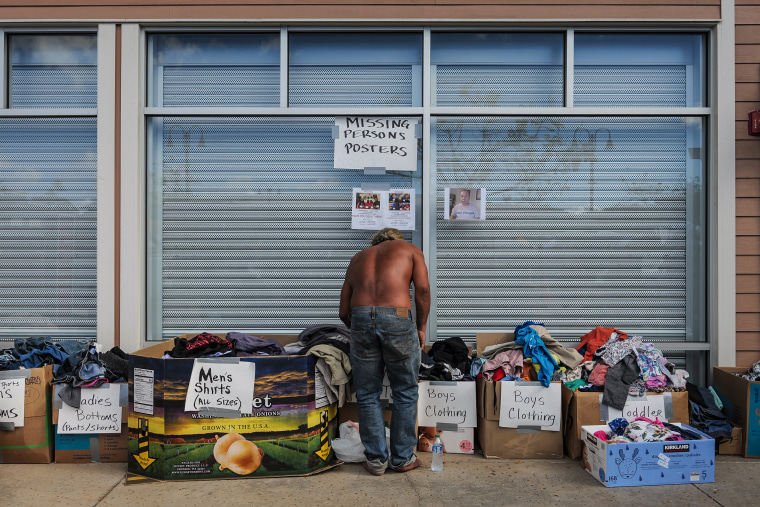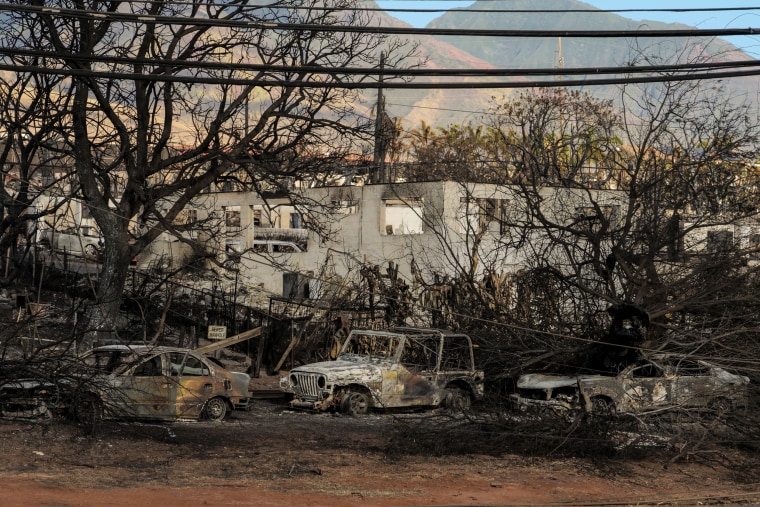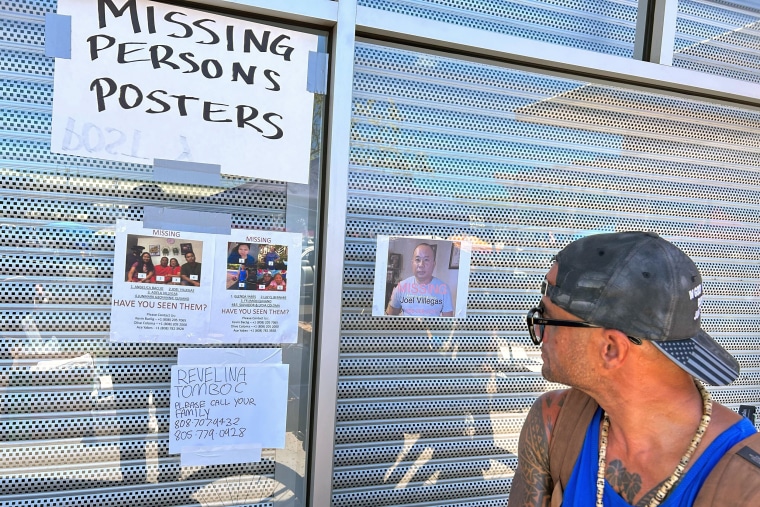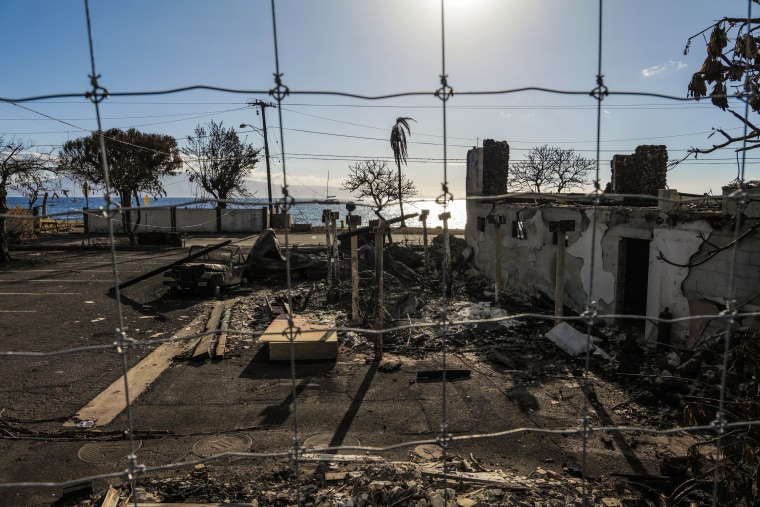LAHAINA, Hawaii — The windswept wildfires that scorched Maui last week were the deadliest in modern U.S. history. Authorities now fear that the death toll will only rise in the days and weeks to come, intensifying the pain of islanders already scarred by catastrophe.
At least 114 people have been confirmed dead, and officials estimate 1,000 more could still be unaccounted for, further complicating the arduous process of locating deceased victims and confirming their identities.
"This is unprecedented," Maui Police Chief John Pelletier said at a news conference Wednesday. "No one has ever seen this that is alive today. Not this size, not this number, not this volume — and we're not done."
About 78% of a designated burn zone that includes the historic seaside town of Lahaina, home to about 12,000 people, had been searched as of Friday night, officials said.
Initially, the number of people believed missing was pegged at more than 2,000, but that number has since fallen, as cellphone communications have been restored and loved ones have been able to make contact. Still, unofficial online lists of the missing are circulating, and people have turned to social media and missing persons posters for help.
Arriving at an accurate count in a mass casualty disaster, particularly one as sprawling and destructive as a wildfire, can take months or even years, researchers and forensic anthropologists say — and that's if the recovery and identification of all victims can be realized at all.
In Maui, which lures hundreds of thousands of tourists every month, the fallout from the wildfires poses its own distinct set of challenges for search teams and forensic specialists.

"We're still trying to take stock of who was in the area during the fire, who is missing," said Lynn Goldman, an epidemiologist and the dean of the Milken Institute School of Public Health at George Washington University, which studied the death toll after Hurricane Maria struck Puerto Rico in 2017. "We're talking about people who lived in Lahaina, tourists, transients."
"The death toll number is always provisional, in a way," Goldman said. "I assume people won't stop trying to find remains and the work will take a very, very long time."
Identifying victims
Of the scores killed, only nine victims had been identified as of Thursday, Maui County officials said.
To help speed up identification, the FBI announced Friday the opening of a site where people could provide DNA samples that would then be matched with the remains that have already been found.
Forensic anthropologists may use dental records and fingerprints to help confirm a person's identity. But in Lahaina, where dental offices were burned down and where the fire was so severe it incinerated cars and melted metal, traditional methods may not apply in each case.
"For individuals who die in mass fatalities from burning or an explosion, it can fragment the body, and very high temperatures can break down the DNA molecules, so it makes the identification process more difficult," said Robert Mann, a forensic anthropologist and medical professor at the University of Hawaii, who is assisting in Maui.
But it's not impossible, he said.
"You can make an identification from one bone or one tooth," he said. "That one bone holds DNA in it."

Maui officials are also turning to rapid DNA-testing machines, which were used in the 2018 Camp Fire in Northern California, a monstrous blaze that claimed 85 lives. DNA-testing devices were used more recently to help identify the remains of soldiers killed in the war in Ukraine.
A spokesperson for rapid DNA-testing company ANDE Corp. said it had dispatched a disaster-response team to assist in Hawaii. The company's instrument creates a unique DNA profile for the human remains, and while that can be done within a couple of hours, awaiting a matching DNA sample, such as a cheek swab from a direct family member — a parent, child or sibling — is what often delays the procedure.
The wildfires in Maui led to entire families going missing and feared dead. Some victims may have no known direct family members, while others may be international travelers or from outside Hawaii, and so direct family members may not be available to provide a DNA sample easily. In addition, there may be people who are wary of sharing their DNA, no matter the circumstances.
ANDE, the rapid DNA-testing company, said it retains the DNA sample only for purposes of finding and confirming an identity match. The FBI's Honolulu Field Office said the agency would not keep samples.
Ultimately, confirming identities as soon as possible means a victim's family can receive a death certificate and move forward with funeral arrangements, insurance claims and other estate matters.
"Something people wonder about is how long is this all going to take," Mann said. "There's no crystal ball to answer the how long question."
Determining a death toll
Puerto Rico's government initially placed the death toll from Hurricane Maria at 64 people.
But that number didn't tell the full magnitude of the powerful storm that unleashed devastation and flash flooding on the island and decimated its power grid. The George Washington University report in 2018 found an estimated 2,975 excess deaths in the six months after the disaster, when people presumably succumbed to a lack of adequate medical care and other causes indirectly related to the hurricane.
The same may hold true in Maui.
"You may see indirect deaths — people who die not because they were exposed to the fires but because of the conditions caused by the disaster," Goldman said.

Further classifying causes of death will be time-consuming. Some people may never be found if they perished in the flames, officials warned.
"For those people who have walked into Lahaina because they really wanted to see, know that they're very likely walking on 'iwi,'" Hawaii Gov. Josh Green said at a news conference this week, referring to the Hawaiian word for bones.
While some survived the wildfires by retreating into the frigid Pacific Ocean as the blaze leveled Lahaina, others who did the same may not have been so lucky.
"It's going to be challenging to account for all the direct deaths, whether it was people who were burned or people who jumped into the ocean and drowned or people who died of smoke inhalation," Goldman said. "It's extremely difficult and extremely painful."
Tracking the missing
The search for Lahaina's missing and the lack of any official tally of who's unaccounted for have forced residents to organize things for themselves.
In the chaotic hours and days after the fire, an ad hoc team of volunteers — many of whom had never met — assembled a publicly available spreadsheet where people could share the names of whomever they were looking for. The list is moderated by a team of 20 from Maui and by others from other parts of Hawaii and beyond.
The number of people who are unaccounted for changes daily as more are identified as either alive or dead and more are listed as missing.
At last count, the missing numbered about 1,000, Sarah Fletcher, who helps maintain the list, said Friday.
The team gets most of its information from a form it posts on Facebook asking families to share details about the people they are looking for, Fletcher said. The team also scours social media and media reports for information, and it has a network of volunteers at relief centers who share information about people they've identified as alive. Some volunteers also reach out directly to families for updates.
It's a round-the-clock effort in which the team tries to balance the release of information with respect for privacy, all while keeping everything in a user-friendly format for people who are not tech-savvy or have language barriers.
"We lose sleep over this thing," Fletcher, 42, said.
For now, the families of the missing can only wait, with some holding out hope that their loved ones are in shelters, hospitals or somewhere else safe.
Ruby Imperial Calma, who lives in Lahaina, said her 64-year-old brother, Rafael Imperial, has been missing since the wildfires began on Aug. 8.

"I cannot leave Lahaina. I have to wait for him. Whenever there's news, I will be just a few minutes away from him,” Calma said in a recent phone interview.
Her 27-year-old nephew submitted a DNA sample, but the family has not yet heard if any bodies, or human remains, are a match.
Rafael Imperial, a married father of two, held three jobs — as a technician with Budweiser, a security guard and a hotel parking attendant — and would call Calma daily, she said, just to ask, "Sis, how are you?"
Now Calma braces herself for a call about her brother's fate.
"Half of my head is telling me that something happened to him. But half of my brain says, 'No. You're not going to give up,'" she said. "There's always hope."
Jon Schuppe reported from Lahaina and Erik Ortiz and Daniel Arkin from New York.



